Gallery Collections
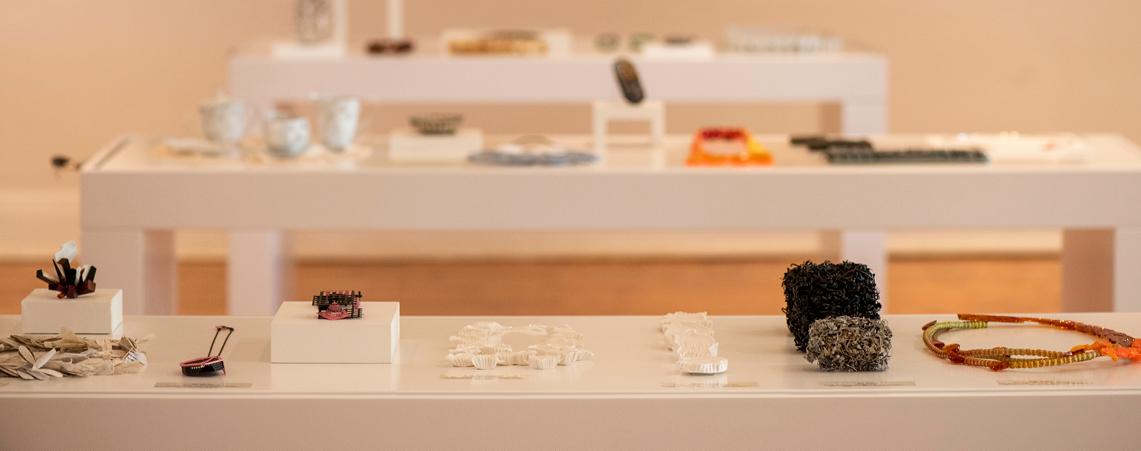
National Contemporary Jewellery Collection
The Griffith Regional Art Gallery (GRAG) is proud to be the custodian of the National Contemporary Jewellery Collection, the only collection of its kind in regional NSW.
The Collection was started in 1988 after the success of a contemporary jewellery exhibition and bicentennial project instigated by GRAG titled Imagination and Metaphor. Four pieces from the exhibition where purchased by the Friends of Griffith Regional Art Gallery and the Australia Council which became the genesis of a jewellery collection which has been growing steadily ever since.
The National Contemporary Jewellery Award (NCJA) was started by the Griffith Regional Art Gallery in 1992 to support the development of the collection and to promote contemporary jewellery practice. The former Friends of the Griffith Regional Art Gallery were significant in the establishment of the collection for GRAG by purchasing one or several entries from the award each year. Since then the NCJA has celebrated 30 years as a biannual acquisitive prize showcasing unique and innovative creations of some of the country’s finest contemporary jewellery practitioners.
The first award in 1992 was sponsored by the Sydney Myer Foundation, today the biennial art prize is sponsored by Griffith City Council. The NCJA’s winning piece is acquired into the collection and they receive a $6,000 prize. The Design Excellent Award, a secondary prize, receives $1,000. A panel of three contemporary jewellery experts preside over the judging of both these awards.
The Gallery has a modest permanent display of a selection of pieces from the collection which is rotated reguarly to allow the people of Griffith, and visitors, to view the array of beautiful contemporary jewellery created by practitioners Australia-wide.
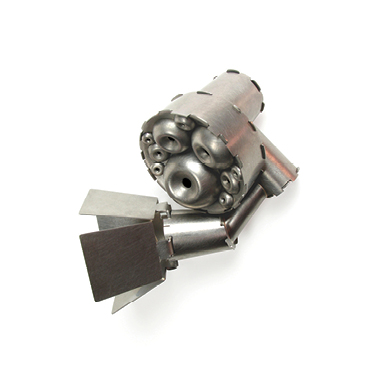
2010 Winner
Simon Cottrell, Bulbs to Barn Doors?, 2009
Stainless steel and monel brooch
The more you look, the more you see. The more that you see, the relationships between your perceptions of certain details begin to progress and change. This brooch is not ‘designed’ in a formal sense, instead it is an intuitive piece, and starts from the memory of all previous works. I just sit down and start making, while watching closely over my own shoulder.
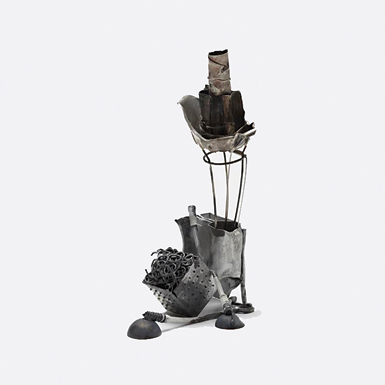
2012 Winner
Christopher Earl Milbourne, Mega Silo with Overbearing Management Quarters, 2010
Sterling Silver, monel, enamel and stainless steel
This work encapsulates an abuse of geometry, a philosophy of construction using destructive techniques to produce fanciful, fragile and architectonic representations of the industrial aspects of the decaying, mythical built environment manifesting themselves as spectre-like apparitions celebrating the doomed and dystopic cityscape of Trinity.
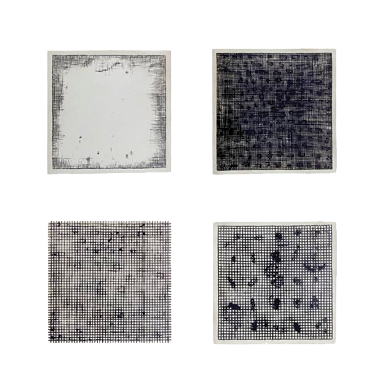
2014 Winner
Emma Fielden, GRID, 2014
Silver, gold and metal brooch in series of five
My work crosses the disciplines of contemporary jewellery and drawing. In my jewellery I use hand engraving techniques to create line-work, pattern and form. Many of these pieces I define as drawings, others are closely related to my drawing practice. In recent works I have found myself exploring the grid: its place in art history, its significance in modern culture, and most particularly its connection with some of my personal interests and concerns which shape my artistic vision.
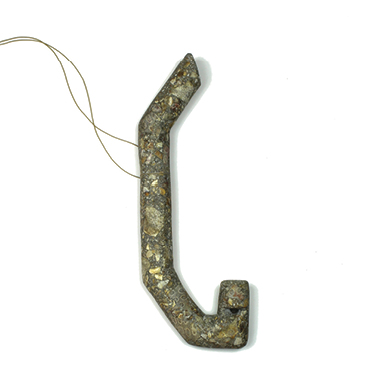
2016 Winner
Claire McArdle, Snorkel (whistle), 2016
Neckpiece of agatised fossil coral, wood, cord
Oceans rise and warm. They are polluted and acidified. The coral bleaches. The snorkel, usually used to observe the living reef, is now used to emit the sharp cry of a whistle. A signal that help is needed. This snorkel is made from the agatised fossils of ancient coral. It takes millions of years and specific geological conditions for the original coral to be replaced by agate. Today, fossil coral is broken down to be used in both fertilisers and water purification.
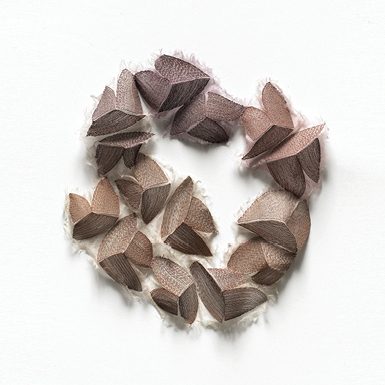
2018 Winner
Michela Pegum, Subtle Body Neckpiece & Brooch, 2018
Silk, copper, steels
These pieces explore the delicate threshold between the tangible and ephemeral through experience and material. The works were made by deconstructing silk organza and then embroidering back into it with copper thread. This new textile is then copper electroplated and thus undergoes a period of growth, as copper is built into the fabric, that allows it to take form and structure and embody the threshold of its counterparts - soft silk and firm metal.
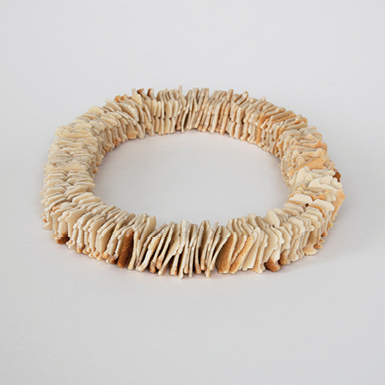
2020 Winner
Halie Rubenis, White Bread, 2020
White bread and LDPE
A living cultural artifact and a symbol of legacy and privilege. Made from slices of generic white bread, and its plastic wrapper, found in a dumpster at the back of a supermarket in Tasmania. Food is thrown out at alarming rates. But this work is not about that exactly—it is a reference to a generation of people that accept this as the norm because that is the world that was passed to them. The bread tag is a mass-produced object that is small, seemingly unremarkable, ubiquitous, an over engineered response to a problem that doesn’t really exist.
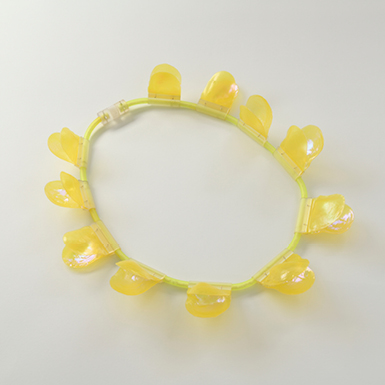
2022 Winner
Katherine Hubble, Cultured Pearl, 2022
Polypropylene, vinyl, 3D printed resin, pvc, freshwater pearls, thread, gold
Katherine Hubble’s work explores the notion of what pearl jewellery could be in the twentyfirst century. It uses the changing role of jewellery to think through the representation of pearls and their shells. This work is Informed by the North West pearling industries methods of harvesting and cultivating the Australian South Sea pearl and Pinctada maxima (pearl oyster) species. Within her practice a combination of traditional jewellery methods and contemporary industry processes are employed. It is the link between these two ways of making that brings the final jewellery outcomes into a contemporary setting.
Thanks to the historical and on-going support of: Griffith City Council, The Friends of the Griffith Regional Art Gallery, current and former Art Gallery staff, The Australia Council for the Arts, Create NSW (Formally Arts NSW), Sydney Myer Foundation, Charles Stuart University, Stuart – Centre for Craft & Design, Courtesy of the Artist Gallery, Meta Lab, previous and current judges, and finally - to all the artists and craftspeople who have participated in the NCJA over the past 30 years.

Couture Collection
The Couture Collection was purchased by Griffith City Council in 2005 and is part of the Griffith Regional Art Gallery Collection. It is a collection which contains work created over the past 50 years and consists of over 200 gowns.
The Couture Collection represents the life’s work of Ross Weymouth and John Claringbold, two established fashion designers working for the majority of their time in Melbourne and spending their final years living in Darlington Point along the Murrumbidgee River, 45km from Griffith where they continued designing couture garments for clients and for those who lived locally.
The collection covers over half a century of work spanning from the late 1950’s to the early 2000’s. Between them, Ross and John had over 90 years experience in the fashion industry and a record 12 Gown of the Year (later Masters of Fashion) Awards.
This collection features their unique interpretation of all major fashion trends through the last six decades. In 2005, Ross and John were recognised for their huge contribution to the industry by being inducted into the Masters of Fashion (previously Gown of the Year) Hall of Fame by the Award Director, Guy Barton.
Ross Weymouth and John Claringbold History
Ross Weymouth was born in Balranald, NSW and John Claringbold in Halls Gap, Victoria. Ross and John met in Melbourne when both were working at the Mutual Store (Ross as a window dresser and John as manager of Display). John started his own Couture business - John Claringbold of Melbourne, in 1962.
Several years later John opened his own fashion house in Swanson Street, Melbourne, which attracted Australia-wide clientèle and included work for Suzanne Steele and former Miss Australia, Michelle Downes, while also working with models such as Janice Waikley and Maggie Tabberer.
Ross’s first commercial designs were produced under the John Claringbold label. After a trip to the UK, he moved back to Melbourne and established himself as an independent designer, developing his own label Bazzar of South Yarra. Ross first entered the Gown of the Year in 1967 and up until 2007, won seven Gown of the Year Awards.
Throughout the 1960’s and 70’s both Ross and John were involved in testing prototype fabrics for the British Nylon Spinners and Fibre Makers. They both believed that synthetics revolutionised fashion, there is plenty of evidence of this in the garments.
Both John and Ross passed away in 2007.







